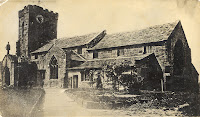 |
| Emma Jane Weston |
These two young sisters were listed as being house maids from London, who had journeyed to Australia as part of Government assisted immigration program to provide relief to the colonies labour shortage.
An article published in the Sydney Morning Herald on the 27 December 1856, describes this situation.
"SYDNEY LABOUR MARKET
The arrival of the Kate, from Plymouth, with government immigrants, will afford a temporary relief to the late very great scarcity of country labour. The immigrants are classified as follows: 49 married couples, 109 single men, 62 single women and 17 children. In the early part of the week the rates going were, in some cases, slightly in advance of the previous week.
OLIVER STAINS, British Foreign Labour Agent, December 26th. 73, Corner of King and Castlereagh Streets."
Under this notice a further article goes on to describe the shortages of labour, especially of female servants.
 |
| St Marylebone |
J.C. GLUE, Labour Agent, December 26, 48 Pitt Street North."
These few articles give you an idea of what greeted my Great Great Grandmother Emma Jane Weston and her elder sister Mary Anne when they arrived in Australia to seek their fortune in a new land.
Emma and Mary Anne were the daughters of William Weston (abt 1816-1867) and Mary Ann Rolf (abt 1816-1896). Mary and William were married at St Marylebone, an Anglican Church on the Marylebone Rd, London on the 3 October 1835.
Emma was born on the 25 June 1839 at 9.00am in the family home at 21 Edwards Street Regents Park. Her father's occupation was listed as House Painter.
 |
| Birth Certificate - Emma Jane Weston 25 June 1839 |
-----------------------
* New South Wales, Australia, Assisted Immigrant Passenger Lists, 1828-1896

in+nurses+uniform.jpg)

































